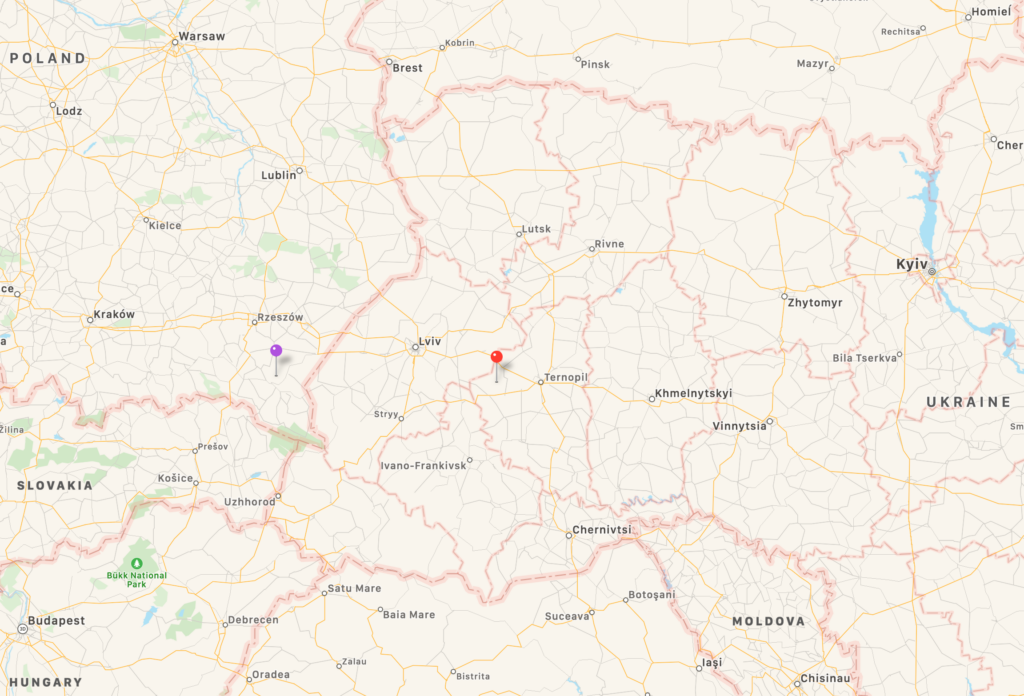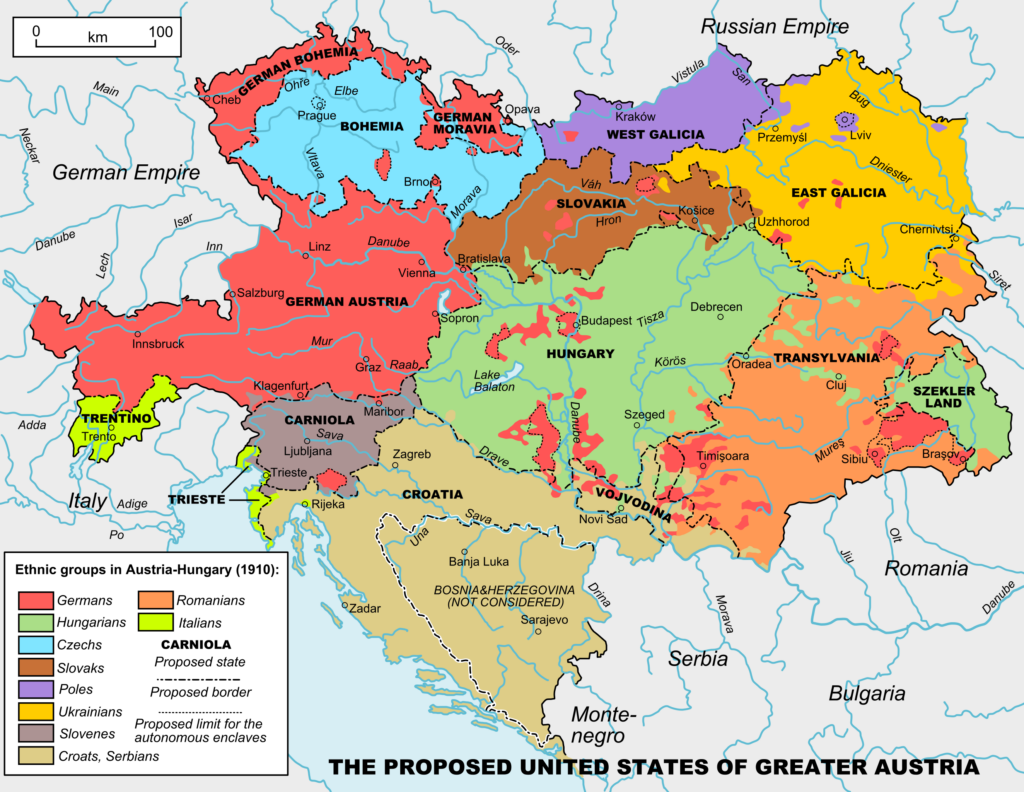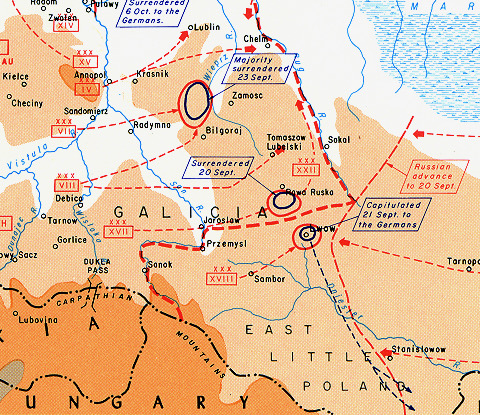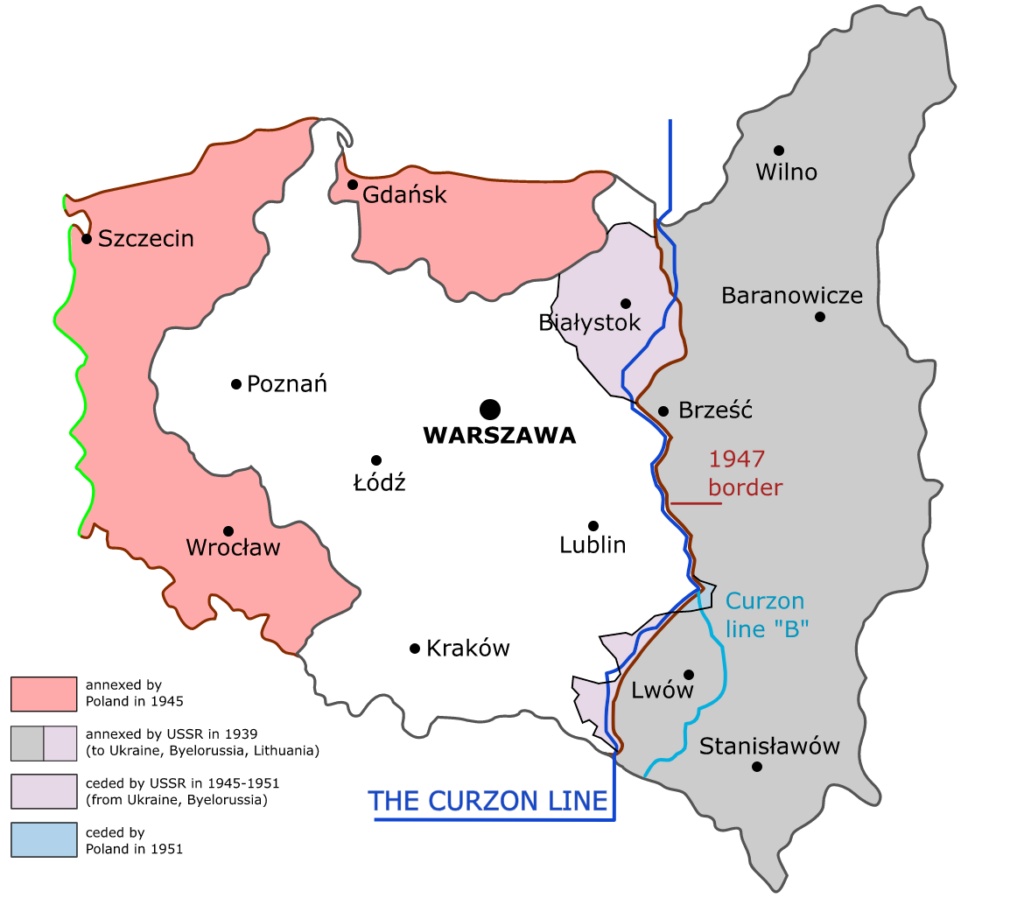Note – this section attempts to provide perspective of what conditions were like in Eastern Europe when the Nazar and Progorowicz families came to America and how world events may have impacted the family which remained in Europe. This is not a detailed or complete history of Ukraine; however, links are provided where appropriate to support additional reading.
Prior to Family Arrival
The Nazar and Progorowicz families came to America in the early 1900s from what is today Western Ukraine (red pin) and Southeastern Poland (purple pin), respectively.

Life was very difficult in this area of Eastern Europe at the turn of the 19th century. In the years leading to World War I, this area was part of the Austro-Hungarian Empire and comprised of multiple ethics groups. The map below shows a proposed “United States of Greater Austria” from 1910 with the Nazar and Progorowicz families being located in East Galacia (southeast of Lviv and southwest of Przemysi, respectively). While this proposal never came to realization, the challenges of having so many separate ethnicities under a single government directly contributed to the start of World War I.

In addition to the political challenges, Galacia had limited resources. It was an agricultural area that supplied food and raw products to the rest of the Austro-Hungarian Empire along with manpower to the army via conscription. Galicia was the poorest province of the empire with many considering it the poorest province in Europe at the turn of the century.
Pictures of current day Koniukhy, Ukraine and Dobra, Poland are provided on the Nazar and Progorowicz pages. There is no evidence that the immigrants who traveled to America ever attempted to go back to their homeland.
World War I
The history of Galacia during the First World War is very complex including the fact that Ukrainians fought on both the Austrian and Russian sides. Hundreds of thousands of Ukrainians fought against each other (i.e., Eastern [Russian] versus Western [Austrian]) and many civilians were killed as battles were fought in and around their villages. Also, over 20,000 Galacian civilians were forced into concentration camps by the Austrian government to prevent collaboration with the Russians.
With respect to the family which remained in Eastern Europe, the Nazar family in Koniukhy, Ukraine was the most exposed to the war as several military advances went through the village and multiple battles were fought in and near the village itself. Of note is the Russian Offensive of 1916 (see beginning on page 161) and Russian Kerensky Offensive of 1917 which included fighting by the famed Ukrainian Sich Riflemen where over 500 men were killed or captured by the Russians in fighting near Koniukhy.
Due to limited available records, it is unknown if any family members in Europe served in the military or were killed during the fighting. However, prior to the war, most men were required to serve in the military at least two years (typically as a reserve), such that it is likely any male between the ages 17-45 served.
It is interesting to note that all three Nazar brothers arrived in America prior to the war when they were between ages 18-20 (possibly before conscription age). They all registered for the draft in America; however, none were drafted to serve in the US Army and they all remained working in the coal mines.
Following World War I, breakup of the Austro-Hungarian Empire, along with the Russian Bolshevik revolution and Ukrainian Nationalism, led to changing borders and conflicts within the today’s Ukraine. Included within this time-frame is the Holodomor or man-made (i.e., Russian induced) famine in Ukraine where at least 3.5 million people were killed between 1932-1933.
World War II
Similar to World War I, the history of Ukraine in WW II is very complex including the fact that Ukrainians fought on both the German and Russian (Soviet) sides and an estimated 5-7 million Ukrainians perished in the war. Note that prior to the start of WW II, the East Galacian area of Figure 2 was part of Poland. The following key events are tied to family history:
Nazi German and Soviet Invasion of Poland/Western Ukraine – In September 1939, Poland was invaded first by Nazi Germany and then Russia. By the end of September, Poland was divided into two territories controlled by Nazi Germany and the Soviet Union. While both Dobra, Poland and Koniukhy, Ukraine were under Soviet control, part of the German/Russian border was formed by the San River in Poland (Dobra is on the east bank of the San River between Przemysi and Sanok as seen in middle of the map below).

During a visit to Dobra in 2019, villagers commented that life was very difficult during this occupation and that abandoned Soviet bunkers remained near the river. While many Ukrainians initially welcomed the Soviets for liberating them from Polish control, the Soviets quickly imposed communist ideology and adminstration (including the confiscation and nationalization of all private property) with the secret police arresting over 100,000 citizens over the two years they were in control.
Nazi Operation Barbarossa – the German attack on the Soviet Union in June 1941 resulted in the Nazi’s quickly taking control over Western Ukraine. While some Ukrainians were thankful for the libration from the Soviets, the Nazi’s quickly implemented their own form of suppression. In addition to the horrors of the Holocaust, one of the idealogical goals of the Nazi’s was to repopulate eastern Poland and Ukraine with Germans and use the existing population as slave labor (Ostarbeiter) for their war effort. The Nazi’s also implemented their “Hunger Plan” with the intention of starving to death millions of people in Eastern Europe and the Western Soviet Union while using their food to feed Germany and the war effort.
With respect to the family, it is clear that any remaining family must have suffered immensely. In addition, Thomas Nazar’s nephew Vasyl Bidnyi (son of his youngest sister Eudocia) was used as slave labor in Germany during the war as a teenager (see Nazar page).
Soviet Operation Vistula – following World War II, the borders for modern day Eastern Europe began to form, including Ukraine which was part of the Soviet Union. However, the new borders created conflict between Poland and Ukraine as there were Ukrainians located in southeastern Poland since the former Galacia covered both countries. To stop support of the Ukrainian Insurgent Army by Ukrainians in Poland, in April 1947, the Soviets forcibly resettled over 140,000 civilians in Southeastern Poland to the northern and western territories recovered by Poland from Germany following the war (see pink areas of Fig 4 below). As a result, the entire population of Dobra, Poland was resettled to the north in the pink area to the southeast of Gdansk such that no members of the Progorowicz family live near the original village today.

Ukraine Today
The Russian invasion of Ukraine which began on February 22, 2022, has been focused in the northern and eastern areas of Ukraine away from where the Nazar family emigrated to America from. However, the remaining family has been impacted by the war, including declaration of martial law and several members escaping to Germany as refuges.